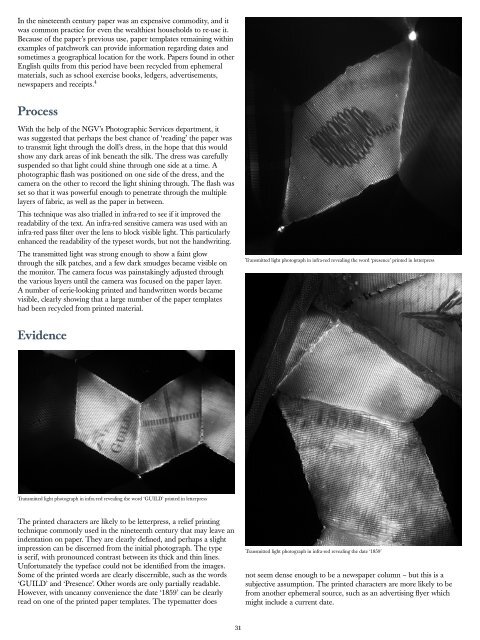FASHION-DETECTIVE
FASHION-DETECTIVE
FASHION-DETECTIVE
You also want an ePaper? Increase the reach of your titles
YUMPU automatically turns print PDFs into web optimized ePapers that Google loves.
In the nineteenth century paper was an expensive commodity, and it<br />
was common practice for even the wealthiest households to re-use it.<br />
Because of the paper’s previous use, paper templates remaining within<br />
examples of patchwork can provide information regarding dates and<br />
sometimes a geographical location for the work. Papers found in other<br />
English quilts from this period have been recycled from ephemeral<br />
materials, such as school exercise books, ledgers, advertisements,<br />
newspapers and receipts. 4<br />
Process<br />
With the help of the NGV’s Photographic Services department, it<br />
was suggested that perhaps the best chance of ‘reading’ the paper was<br />
to transmit light through the doll’s dress, in the hope that this would<br />
show any dark areas of ink beneath the silk. The dress was carefully<br />
suspended so that light could shine through one side at a time. A<br />
photographic flash was positioned on one side of the dress, and the<br />
camera on the other to record the light shining through. The flash was<br />
set so that it was powerful enough to penetrate through the multiple<br />
layers of fabric, as well as the paper in between.<br />
This technique was also trialled in infra-red to see if it improved the<br />
readability of the text. An infra-red sensitive camera was used with an<br />
infra-red pass filter over the lens to block visible light. This particularly<br />
enhanced the readability of the typeset words, but not the handwriting.<br />
The transmitted light was strong enough to show a faint glow<br />
through the silk patches, and a few dark smudges became visible on<br />
the monitor. The camera focus was painstakingly adjusted through<br />
the various layers until the camera was focused on the paper layer.<br />
A number of eerie-looking printed and handwritten words became<br />
visible, clearly showing that a large number of the paper templates<br />
had been recycled from printed material.<br />
Transmitted light photograph in infra-red revealing the word ‘presence’ printed in letterpress<br />
Evidence<br />
Transmitted light photograph in infra-red revealing the word ‘GUILD’ printed in letterpress<br />
The printed characters are likely to be letterpress, a relief printing<br />
technique commonly used in the nineteenth century that may leave an<br />
indentation on paper. They are clearly defined, and perhaps a slight<br />
impression can be discerned from the initial photograph. The type<br />
is serif, with pronounced contrast between its thick and thin lines.<br />
Unfortunately the typeface could not be identified from the images.<br />
Some of the printed words are clearly discernible, such as the words<br />
‘GUILD’ and ‘Presence’. Other words are only partially readable.<br />
However, with uncanny convenience the date ‘1859’ can be clearly<br />
read on one of the printed paper templates. The typematter does<br />
Transmitted light photograph in infra-red revealing the date ‘1859’<br />
not seem dense enough to be a newspaper column – but this is a<br />
subjective assumption. The printed characters are more likely to be<br />
from another ephemeral source, such as an advertising flyer which<br />
might include a current date.<br />
31


